Meetspace VR
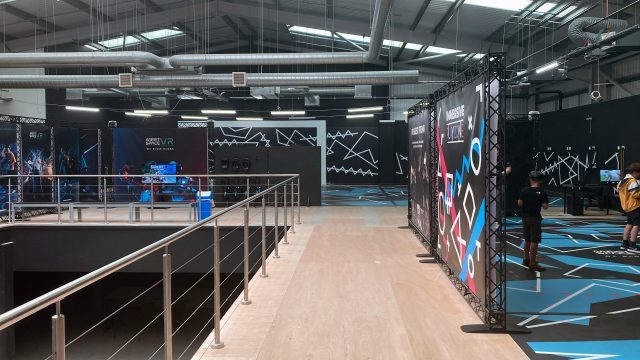 Meetspace VR has locations across several UK cities. This venue is in Stretford in the North of England, close to Manchester United’s football ground in an industrial estate. It’s a scrappy-looking temporary space and not easily accessible by public transport.
Meetspace VR has locations across several UK cities. This venue is in Stretford in the North of England, close to Manchester United’s football ground in an industrial estate. It’s a scrappy-looking temporary space and not easily accessible by public transport.
At the time of my visit on a weekday morning there’s a single family of four playing in a smaller space, but the manager Harry says it’s mostly corporate gigs during the week and the weekends are fully booked for friends and families.
The big draw is the massive 10 × 20 metre arena. Harry doesn’t look like he’s joking when he says he’s clocked people running several kilometres in a half-hour game of their most popular title, Ubisoft’s Far Cry VR.
You are armed with a heavy plastic weapon but there are no haptic suits or environmental extras. Yet sometimes it’s enough just have all that space. It’s also all exterior based tracking and wireless rendering, so no backpacks here.
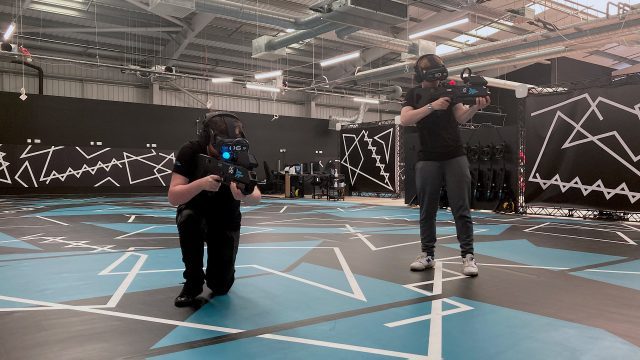 There’s a short tutorial video of how to switch between and operating the assault rifle and crossbow: “Remember you still exist in the real world so stay safe! Keep your distance from other players, keep your distance from real walls, get too close and an alarm will sound and the game will pause for every player,” the attendant says.
There’s a short tutorial video of how to switch between and operating the assault rifle and crossbow: “Remember you still exist in the real world so stay safe! Keep your distance from other players, keep your distance from real walls, get too close and an alarm will sound and the game will pause for every player,” the attendant says.
Far Cry VR is basically just going to war with your mates, with wave after wave of enemies. I’m playing with James who carries me through and proceeds to go right to the top of the leaderboards with his kills.
I’m not used to the huge free roaming space and am walking around gingerly at first because I just haven’t been programmed to actually run in VR.
It’s liberating to be able to physically sprint, duck, and hide behind pillars across a decent sized area. But I can’t get the hang of the crossbow. “Don’t worry, it’s rubbish,” says James.
At the other end of the scale, we play Engineerium, a controller-free adventure game for kids which feels like M.C. Escher has made a platformer to walk around. After one too many twists I start to feel quite nauseous.
We switch to the smaller 6 × 6 metre area and play Arrowsong, Cook’d Up, and Escape Quest Espionage Express.
Meetspace VR has got one of the best range of games for all ages and levels. There’s all of Ubisoft’s VR escape rooms and I’d loved to have played Alice in Wonderland. Next time.
Layered Reality
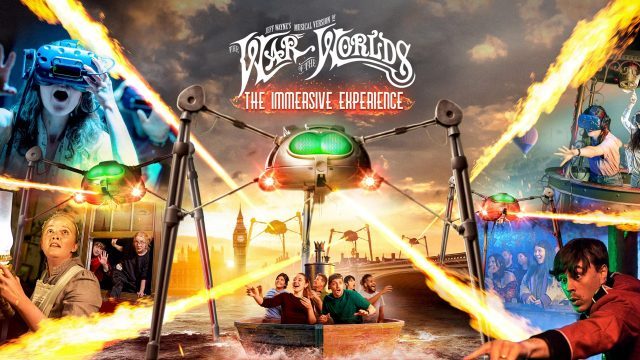 The outlier of our arena adventures, Jeff Wayne’s War Of The Worlds Immersive Experience from Layered Reality isn’t an out-and-out VR arcade and can’t be compared like-for-like.
The outlier of our arena adventures, Jeff Wayne’s War Of The Worlds Immersive Experience from Layered Reality isn’t an out-and-out VR arcade and can’t be compared like-for-like.
It’s a two-hour theatrical interactive performance with live actors which incorporates VR in three of its 24 scenes. But far from being incidental they are both crucial to the story and extraordinary in their execution.
The piece is inspired the iconic best-selling double album from 1978 featuring the unmistakable narration of Richard Burton and David Essex, which in turn was based on the novel by HG Wells, published in 1898.
The chances of anything coming from Mars are a million to one, but still they come…
It’s Victorian-era London and the Martians have invaded. We are led into a musky room and our first costumed actor introduces us to the story.
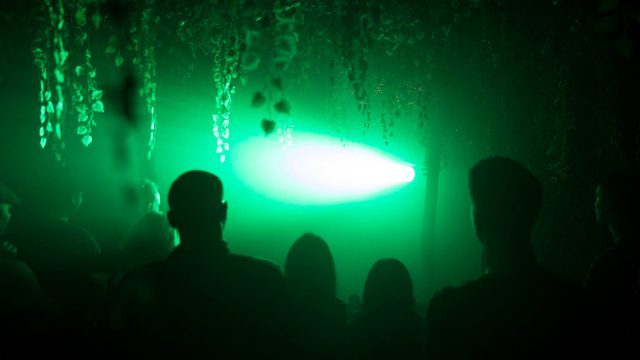 Between running through barracks and escaping down slides we meet a Welsh soldier, a parlour maid and a dying woman. It’s great fun.
Between running through barracks and escaping down slides we meet a Welsh soldier, a parlour maid and a dying woman. It’s great fun.
Through yet another door we are taken to a boat. It’s time to escape London. You climb aboard with six other people in pairs and put your headsets on.
Your fellow passengers are digitally rendered as costumed characters who move in real time, with the narrators of the story at the back of the boat.
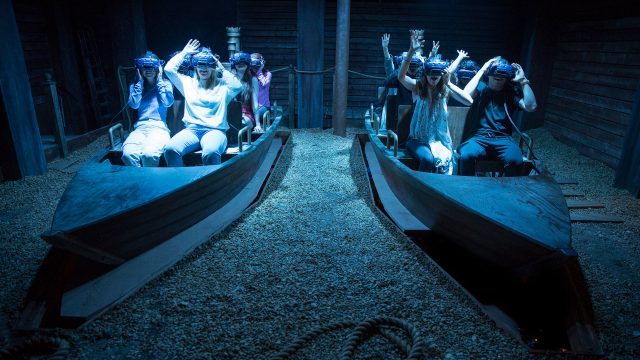 Vicky takes up the story: “You are going down the Thames with Forever Autumn playing through the headphones.”
Vicky takes up the story: “You are going down the Thames with Forever Autumn playing through the headphones.”
“The boat is on hydraulics, so when we are in open water it starts to rock with the waves and I think they even sprayed water on us and used fans to emulate wind. At one point the lady behind was screaming as the Martians hit us with their heat rays. They were sinking this other ship to the sounds of Thunder Child. It’s all very epic, the music is building and your boat is rocking and then a big wave comes over…”
“The second VR scene you have to go into a confessional booth by yourself and they lock the door behind you. And then suddenly a curtain opens and you start to hear other people scream.”
“The last scene takes places in a hot air balloon. You get into a basket in pairs and they are pumping heat down through the middle so when you fire the burners you can feel it going down your neck. You are leaving Earth and you look back and you are travelling through space. Then you land on crater in Mars. It was amazing.”
– – — – –
Download the latest issue of Gibby’s Guide here
Disclosure: Tickets were requested for and provided by Divr, DNAR VR, Meetspace VR, and Layered Reality. Our thanks to them.






